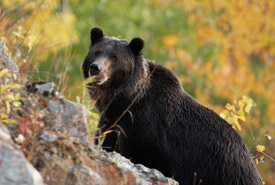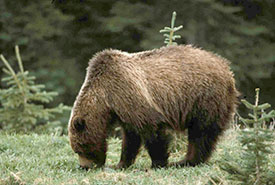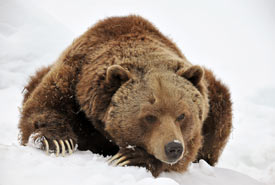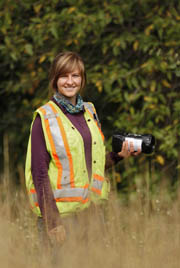Celebrating Canadian species: Grizzly bear

Grizzly bear (Photo by Peter Sulzle)
When I put my boots on in the morning, I never really expect or seek to see a grizzly bear. Despite the fact that my Rocky Mountains backyard is home to many brown bears, any encounter always feels like a surprise. Meeting a bear in the wild conjures excitement, fear and absolute awe at these incredible creatures.
Though seeing a bear is remarkable and memorable, what can I do to ensure we both leave the encounter happily and safely?
I pondered this question after encountering one of these beautiful creatures this summer while hiking in grizzly country. It is always a pleasure seeing grizzly bear, as they are a beautiful example of Canada's majestic wildlife. Their incredible power and intelligence, not to mention their rough brown coats, are mesmerizing. One of the grizzlies I saw this year was grazing in an alpine meadow as we rounded a corner on the trail during a hike. It was completely focused on rototilling the hillside in search of delicious morsels that would add to its fat reserve to carry itself through winter. It didn’t see us, hear us or smell us, but diligently continued its work of flipping over rocks and digging out plant roots.

Grizzly bear, AB (Photo by Mike Gibeau)
Our destination was just over the rise, well away from where the grizzly was having his lunch. Seeing as he was clearly occupied and we could likely keep well out of his way if we stayed high on the hillside, we certainly could have chosen to continue on our way, but it didn’t seem right to me. As I stood there watching it, I thought about the differences in our motivation for being there. My hiking partner and I didn’t need to be in that valley, we were simply there to see beautiful places and to get outside; the bear, on the other hand, was there to survive.

Grizzly bear (Photo by Caroline Henri)
With one last glance at this beautiful creature, we turned tail and made our way back down the trail. In that moment, it felt like the right thing to do. One of the best ways we can ensure our continual enjoyment of these creatures is to give a grizzly bear lots of space and respect their needs for survival.
Grizzlies need anywhere from 25 to 700 square kilometres of land for feeding, denning and finding mates. With encroaching human activities such as roads and development, grizzly bears are at risk of losing their homes and coming into conflict with humans. Their once-widespread range on the North American continent has shrunk to just a number of strongholds, many of which are in BC, Alberta and the Yukon. Maintaining these strongholds with high quality habitat and increasing connectivity on the landscape is vital for grizzly bear survival.
The Nature Conservancy of Canada (NCC) works diligently to protect these landscapes in BC and to ensure connectivity between habitats. Large-scale projects such as Darkwoods protect large tracts of grizzly habitat, while smaller, strategically-located conservation lands such as Luxor Linkage and the Frog Bear Conservation Corridor protect vital movement corridors for grizzly bears and other wide-ranging wildlife.
Although we may be drawn to the beautiful places that are home to these bears, the greatest gift we can give a grizzly is the space it needs.
Get into nature and the holiday spirit by sharing joy and a tweet below:
The grizzly bear is one of nine species featured in NCC’s gift giving campaign: Gifts of Canadian nature. To learn more and to give the gift of conservation this holiday season, click here.
Did You Know?
Roots is helping to protect Canadian habitat and the species that they sustain, including grizzly bear. Find out how, here.


